Progressive Dairyman Editor Walt Cooley attended World Ag Expo in Tulare, California, Feb. 9-11, 2016. He walked the show seeking out booths that were stopping traffic or displaying something new that might be useful to dairy producers. Below are his thoughts and comments about what he saw.
Several of these “cool things” were captured on video and are embedded as Vine videos below.
Record-breaking attendance
Warm, clear weather with highs in the mid-70s brought out huge crowds during the three-day show. Attendance was 106,349, a new record for overall show attendance.
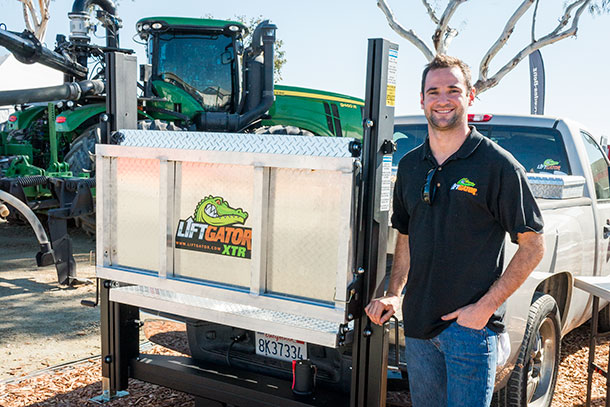
Engineering student from Bakersfield dairy creates new portable liftgate
A new hitch-mounted, electric-powered liftgate for a pickup truck was on display during the show. It’s the senior project of Cal-Poly student Marty Affentranger.
The engineering undergraduate grew up on a dairy and one day plans to go back to his family’s 3,500-cow farm in Bakersfield, California. For now, he’s selling his lifts to delivery companies and farmers. More than 60 have been sold since the product launched last year. Affentranger says the most interesting aspect of the product to farmers is that it’s removable and fits any brand or style of truck.
“You can roll it right up to your truck, raise it up to match your hitch-receiver height and slide it right in,” Affentranger says.
Dairy farmers are using the lift to haul irrigation pumps or tractor tires out into crop fields for replacement, Affentranger says. His invention was named a top 10 new product by World Ag Expo.
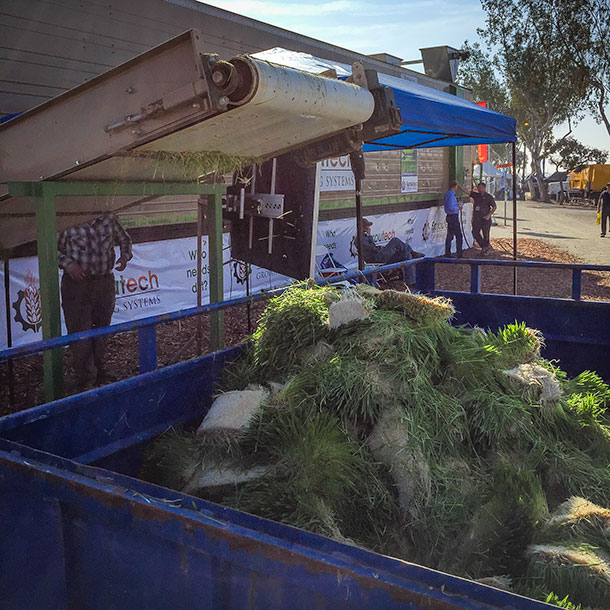
Automated fodder systems take a step forward
One of the booths stopping traffic around the Farm Credit Dairy Center was a 1-ton-per-day, hands-free sprout-growing unit housed in a 53-foot shipping container. The system was designed and built by SproutTech and is available through FodderWorks. Crowds gathered several times throughout the day to watch the unit feed out fodder at the push of a button.
The unit on display at the show was a prototype and has been functioning on a dairy in Orland, California, for eight months. The automated fodder units that are available now commercially would be sold in 2-ton-production-unit increments and be fixed buildings, unlike the prototype on display at the show. For example, a 10-ton-per-day automated production unit would be housed in a 12,000-square-foot building.
“This is something people have wanted to see for some time,” says Kurt Chittock, president and CEO of FodderWorks. “The response at the show has been very positive.”
Chittock says a working version of the fixed-structure version of the automated production unit is operating in southern Utah right now.
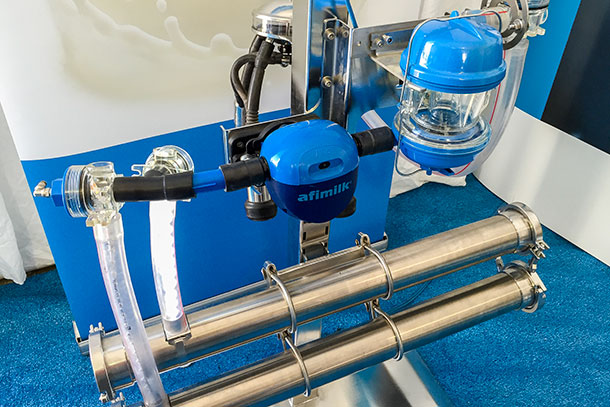
In-line milk analysis woos show-goers
Milking equipment company AfiMilk displayed its new in-line milk analysis unit during the show. The new product won an innovation award last fall and was the topic of a seminar held during the show.
“I call it a cow translator,” said Aurora Villarroel, a veterinarian and application support manager for AfiMilk. Her presentation on the timely diagnosis of ketosis and other metabolic diseases explained how the data from the unit can be used in disease prevention.
“The more intense management systems we see today are leading to farmers being more interested in prevention of all kinds of metabolic diseases,” Villarroel said. “Newer technologies like these help them do that.”
The grapefruit-sized unit uses photoelectric sensors to automatically measure milk components and milk conductivity for every cow, every milking. Villarroel explained how these measurements and deviations from their standard baseline can be used as a leading indicator for negative health events affecting the cow, such as subclinical ketosis, mastitis and rumen acidosis.
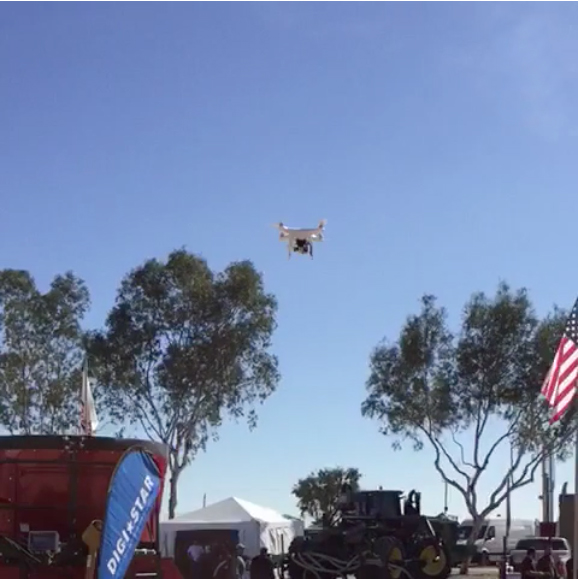
Drones and more drones
A growing number of booths at farm shows are touting the capabilities of drones for farm use. One booth near the Farm Credit Dairy Center was stopping traffic with a live demonstration of one.
Wally Stimpert, a regional manager with Roto-Mix, brought his four-propeller drone and its extreme sports camera to the show. He was flying it around the company’s outdoor exhibit.
Sounding like a swarm of bees, it would stop traffic as show-goers watched him perform airborne maneuvers. The exhibition didn’t last long as the drone’s battery would only last for 15 minutes at a time.
Stimpert says the drone-mounted camera is useful beyond just entertainment. He uses it to show customers a bird’s eye view of the mixers he sells while they are in operation.
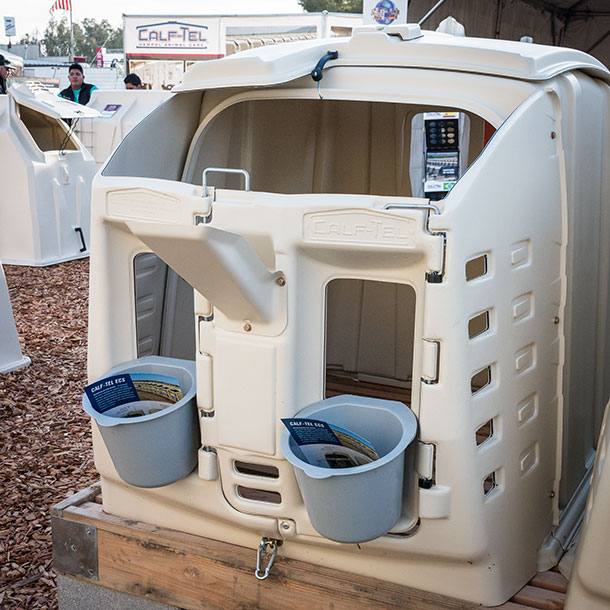
New Western-style plastic calf hutch unveiled
Western calf-raisers were the first to see a new calf hutch design during World Ag Expo. The five-piece, molded plastic hutch by Calf-Tel was specifically designed for a California approach to calf raising, says Brian Wesemann, the company’s director of sales.
“It’s a unique unit that fits more closely with a certain segment of management style that places units on a wooden base and are found in warmer, arid climates,” Wesemann says.
The new hutch has several client-requested features, including a hinged front door, sliding roof, bottle holder and anchoring clips and brackets. Two of the new plastic hutches are designed to fit on the same stand that would fit a traditional raised-wooden triple hutch.
“The feature I was surprised was most requested was the working door,” Wesemann says. “It was a ‘nice-to-have’ previously ... but as we got closer to bringing this to market, calf-raisers said they could see the benefits of it.”
The new model began as a development project in 2010 and has since been designed with ongoing input from calf-raisers, Wesemann says. The company estimates about 20 percent of U.S. calves are raised in this housing style.
Wesemann says the new hutch will provide calf-raisers with a “preferable solution” to wood calf housing.
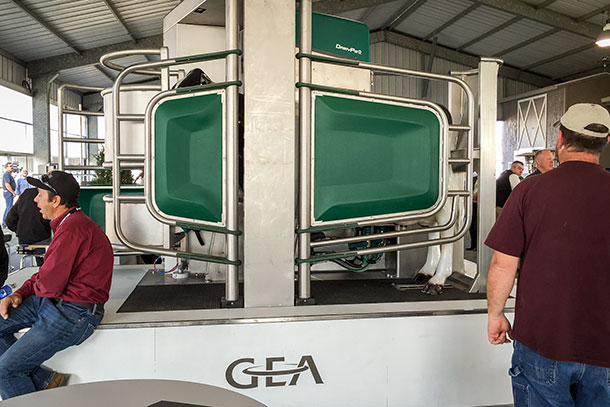
A single-stall robotic milker of every color
Dairy producers can now get a single box-stall robotic milking unit in blue, red, black, orange – and now green. GEA Farm Technologies displayed its Monobox Automated Milking system for the first time at the show. The box-unit was developed using the same technology used in the stalls of its automated rotary, and they distilled it for use in a single-stall box. According to the company, dairy producers like to have both the rotary and single-stall options available to consider.
“We see about a 50-50 split [between interest in automated rotary versus single box-stall] depending on the mindset of the dairymen. Some people like the fact that with voluntary milking, there is no holding area and that cows are free to do what they want,” says Stuart Marshall, a robotic milking specialist with GEA.
One of the differentiating features dairymen were talking about is its ability to do in-liner dipping.
“We guarantee that if we milk a teat, we’re going to wash the teat,” Marshall says.
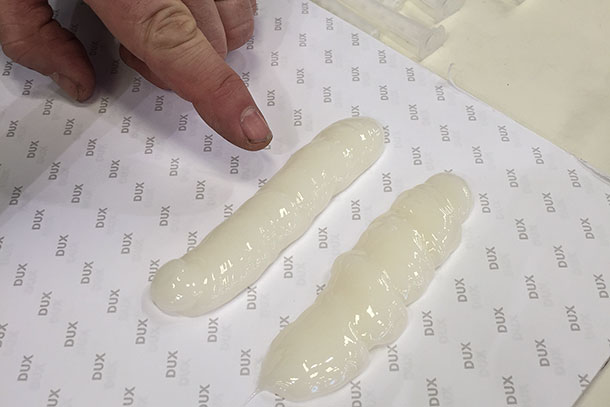
New automatic hoof block glue gun demonstrated
Vettec showcased a new six-speed, battery-powered automatic glue gun for use in applying hoof blocks. Instead of pumping the trigger like a manual glue gun, the new unit mixes and dispenses glue automatically when holding down the trigger.
“Its speed and consistency are most impressive,” says Larkin Green, Western region manager for Vettec. “All you have to do is hold the trigger. For the end user, it’s a world of difference.”
Several employees who saw Larkin’s demonstration of the new glue gun were calling their supervisors requesting to purchase the unit on-site.
Rear-steering now available on a windrower
Another top 10 new product winner on display was Hesston’s WR9870 Series self-propelled windrower with a new rear-steering option. The company says the new rear-steering feature will make its equipment lineup “light years ahead” of other hay-cutting options.
“This windrower used to turn on a dime. It will actually turn in less than that now; it will actually turn backwards; it will turn within itself,” says Matt LeCroy, a senior product marketing specialist with AGCO, which manufactures the Hesston and Massey Ferguson equipment lineups. “Rear-steering really helps in tight areas or when your guidance is on and you’re trying to hold a line, especially on a contoured line or side hill.”
The new feature will help to keep a cutting head fuller, especially at faster speeds or around tight corners, LeCroy says.
“The hay guys are very excited about it,” LeCroy says. “Out here in California, Arizona and Idaho, compared to other parts of the country, producers are cutting hay at a minimum of 12 mph. When you get up into the 14 to 16 mph range while cutting hay, you need GPS guidance to be accurate. They are super excited about this because its maintaining their line even better.” PD
PHOTOS: Staff photos.






